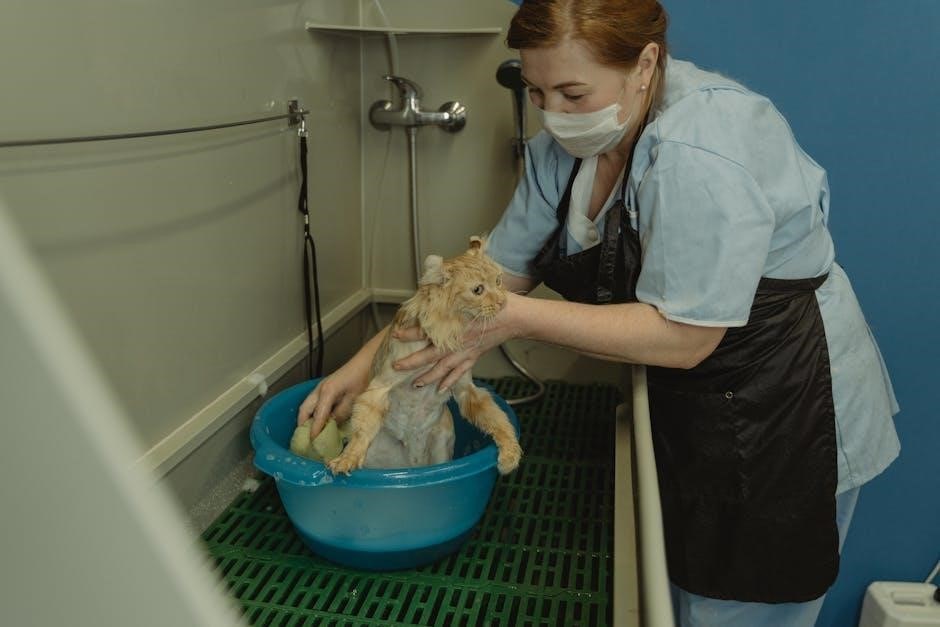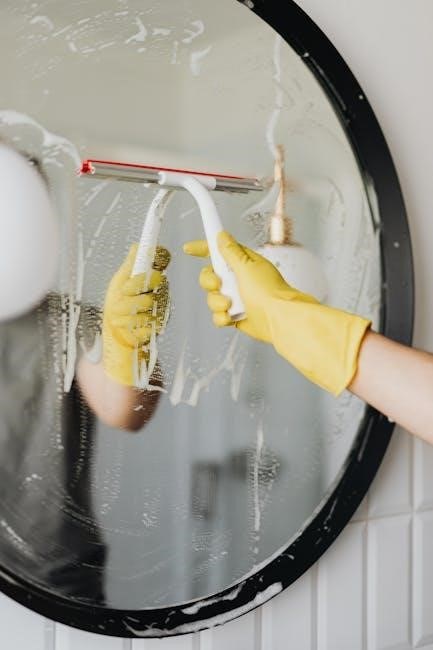Bed baths are a fundamental aspect of nursing care, ensuring hygiene and comfort for patients with limited mobility. This procedure involves meticulous steps to maintain patient dignity and safety, addressing physical and emotional needs while preventing complications. It is a vital skill for nurses and caregivers, requiring attention to detail and compassion.

Overview of Bed Bath Nursing Procedure
The bed bath nursing procedure is a structured process aimed at maintaining patient hygiene and comfort. It begins with gathering essential supplies and preparing the patient and environment to ensure safety and privacy. The procedure typically involves washing the patient’s face, neck, and ears, followed by the upper body, arms, hands, chest, and abdomen. The lower body, including legs, feet, and perineal area, is cleaned next. Nurses must assess patient limitations to tailor the bath appropriately. Using mild soap and warm water helps prevent skin irritation. Throughout the process, maintaining patient dignity and ensuring thorough cleansing are prioritized. Proper documentation and follow-up are crucial to track the patient’s condition and adjust care as needed, ensuring overall well-being.
Importance of Bed Baths in Patient Care
Bed baths are crucial for maintaining patient hygiene, preventing infections, and promoting skin health. They help identify skin issues like rashes or sores early, enabling timely intervention. Regular bathing boosts patient morale and dignity, contributing to emotional well-being. It also reduces body odor and discomfort, improving overall quality of life. For immobilized patients, bed baths are essential as they cannot bathe independently. Nurses play a key role in ensuring the procedure is safe, comfortable, and tailored to individual needs. Regular bed baths are vital for infection control and maintaining a clean environment, which is critical in healthcare settings. This procedure is a cornerstone of nursing care, addressing both physical and emotional patient needs effectively.

Purpose and Types of Bed Bath
Bed baths maintain hygiene, prevent infections, and enhance patient comfort. Types include complete, partial, and sponge baths, catering to varied patient needs and mobility levels.
Purpose of Bed Bath
The primary purpose of a bed bath is to maintain personal hygiene, prevent infections, and promote patient comfort. It helps remove dirt, sweat, and bacteria, reducing the risk of skin irritation and infections. Bed baths also enhance patient dignity and emotional well-being by providing a sense of cleanliness and refreshment. Additionally, it allows nurses to assess skin condition, detect early signs of pressure sores or rashes, and address them promptly. Regular bed baths are essential for immobile or bedridden patients who cannot bathe independently, ensuring their overall health and quality of life are maintained. This procedure is tailored to individual needs, respecting patient preferences and physical limitations.
Types of Bed Baths
Bed baths can be categorized into different types based on the patient’s needs and mobility. A complete bed bath involves washing the entire body, while a partial bath focuses on specific areas like the face, hands, and perineal region. Sponge baths are commonly used for bedridden patients, employing a sponge or washcloth to clean the body without immersion. In some cases, a towel bath may be performed, using a damp towel to gently cleanse the skin. Each type prioritizes patient comfort, hygiene, and safety, adapting to individual circumstances and physical limitations; Understanding these variations allows caregivers to provide personalized and effective care, ensuring the patient’s well-being and dignity throughout the process.

Preparation for Bed Bath
Gathering supplies, ensuring warm water, and preparing the environment are crucial. Patient comfort and privacy must be maintained throughout the process. Proper preparation ensures safety and dignity.
Gathering Supplies
Gathering the right supplies is essential for a smooth bed bath procedure. This includes a basin, warm water, mild soap, soft washcloths, towels, gloves, and a bath blanket. Ensure all items are within reach to minimize movement during the bath. Check the water temperature to avoid discomfort and have a clean change of linens ready. Organizing these supplies beforehand helps maintain efficiency and patient comfort. Additionally, preparing a barrier for the bed and ensuring the room is at a comfortable temperature are important steps. Having everything ready allows the caregiver to focus on the patient’s needs and safety throughout the process.
Preparing the Patient and Environment
Preparing the patient and environment is crucial for a safe and comfortable bed bath. Begin by offering the patient a urinal or bedpan to minimize disruptions during the procedure. Ensure privacy by closing curtains or using screens. Position the patient in the center of the bed and remove any excess bedding. Adjust the room temperature to a comfortable level to prevent chilling. Remove any soiled linens and have clean ones ready for after the bath. Ensure the bed wheels are locked and use non-slip mats to prevent falls. Organize supplies within easy reach to save time and reduce movement. This preparation ensures the process is efficient, respectful, and focused on patient comfort and safety.

Step-by-Step Bed Bath Procedure
A bed bath involves a systematic approach, ensuring patient comfort and safety. It includes washing, rinsing, and drying each body part, while maintaining hygiene and dignity.
Washing the Face, Neck, and Ears
Begin by wetting a clean washcloth with warm, soapy water. Gently wash the patient’s face, paying attention to the forehead, nose, and chin. Avoid harsh scrubbing, especially around the eyes. Rinse the cloth thoroughly and wipe away soap residue. Next, clean the neck, ensuring to remove dirt or sweat. For the ears, dampen a cotton ball with soapy water and gently wipe the outer surface, avoiding the ear canal. Use a clean, damp cloth to remove any remaining soap. This step ensures hygiene and comfort, maintaining the patient’s dignity throughout the process.
Cleaning the Upper Body (Arms, Hands, Chest, Abdomen)
Begin by washing the patient’s arms, starting from the shoulder and working down to the hand. Use a soapy washcloth to clean the front and back of each arm, paying attention to creases and folds in the skin. Gently clean under the nails and between fingers. Next, move to the chest and abdomen, ensuring to clean all areas thoroughly without applying too much pressure. Use a clean, damp cloth to rinse away soap residue. Finally, wash the hands, carefully cleaning between the fingers and under the nails. This step ensures the upper body is clean and free from dirt or bacteria, promoting hygiene and comfort for the patient.
Cleaning the Lower Body (Legs, Feet, Perineal Area)
Start by gently washing the legs, beginning at the thighs and moving downward to the feet. Use a soapy washcloth to clean the front and back of each leg, paying special attention to creases and folds. Cleanse the feet thoroughly, including between the toes. Next, address the perineal area, ensuring to maintain patient privacy and dignity. Use a clean, damp cloth to rinse away soap and moisture. Special care should be taken to keep this area dry to prevent skin irritation or infection. This step ensures the lower body is clean and hygienic, promoting comfort and preventing potential skin issues for the patient.

Patient Assessment and Care

Patient Assessment and Care
Patient assessment is crucial to identify individual needs and limitations before and during the bed bath. This ensures personalized care, safety, and comfort, adapting the procedure to each patient’s specific requirements and preferences. Regular monitoring and adjustments are made to maintain dignity and prevent discomfort or complications. This tailored approach fosters trust and ensures the patient feels secure throughout the process. It also helps in addressing any physical or emotional challenges promptly, making the bed bath experience as comfortable and stress-free as possible for the patient. Proper assessment and care are vital for effective nursing practice in bed bath procedures.
Evaluating Patient Needs and Limitations
Evaluating patient needs and limitations is critical to provide personalized care during bed baths. This involves reviewing the patient’s health records to identify physical limitations, medical conditions, or cognitive impairments that may affect the procedure. Assessing mobility, strength, and balance helps determine the level of assistance required. It is also important to consider the patient’s preferences, cultural values, and comfort level to ensure dignity and respect. Identifying skin conditions, wounds, or sensitive areas ensures gentle care and prevents discomfort or injury. Additionally, evaluating the patient’s ability to communicate and follow instructions aids in tailoring the bed bath process. This comprehensive assessment enables nurses to adapt the procedure to meet individual needs, ensuring safety, comfort, and effective hygiene. Regular reassessment during the process is essential to address any changes or concerns. By understanding these factors, caregivers can deliver compassionate and efficient care. Proper evaluation ensures the bed bath is both therapeutic and respectful, promoting overall well-being.
Maintaining Patient Comfort and Safety
Maintaining patient comfort and safety is paramount during bed baths. This involves ensuring the environment is warm and free from drafts to prevent chilling. Using soft, clean linens and towels helps protect the patient’s skin. Keeping the patient covered with a bath blanket or towel maintains privacy and dignity. Positioning the patient correctly and supporting their body during the bath prevents strain or falls. Regularly checking water temperature to avoid burns is crucial. Encouraging the patient to participate as much as possible promotes independence and reduces anxiety. Providing reassurance and communication throughout the process helps the patient feel secure. Addressing any discomfort immediately ensures a positive experience. Safety measures, such as securing bed wheels and using non-slip mats, further minimize risks. Prioritizing comfort and safety ensures a relaxing and protective bed bath experience for the patient. This approach fosters trust and overall well-being. Proper care enhances the patient’s emotional and physical health.
Documentation and Follow-Up
Documentation involves recording the bed bath process, including date, time, and patient response. Follow-up ensures skin condition is monitored and hygiene is maintained.
Recording the Bathing Process
Accurate documentation of the bed bath process is essential for accountability and continuity of care. Nurses should record the date, time, and details of the procedure, including any challenges faced. Noting the patient’s physical condition, such as skin integrity or discomfort, is crucial. This documentation also includes the patient’s feedback and any specific requests made during the bath. Maintaining detailed records ensures that future care is tailored to the patient’s needs and preferences. Proper documentation also supports legal compliance and communication among healthcare team members. By systematically recording each step, nurses can track progress and identify areas for improvement in the bathing process.
Monitoring Skin Condition and Hygiene
Monitoring skin condition and hygiene is a critical component of bed bath care. Nurses should regularly inspect the patient’s skin for signs of redness, irritation, or breakdown, particularly in high-risk areas like the sacrum and heels. Proper hygiene practices, such as using mild soaps and avoiding excessive scrubbing, help maintain skin integrity. Ensuring the skin is thoroughly dried, especially in folded areas, prevents fungal infections. Additionally, applying moisturizers can prevent dryness and cracking. Regular assessment allows early detection of potential issues, enabling timely interventions to promote healing and prevent complications. This vigilance supports overall patient health and comfort, making it a cornerstone of effective nursing care.



